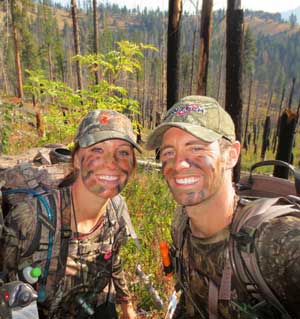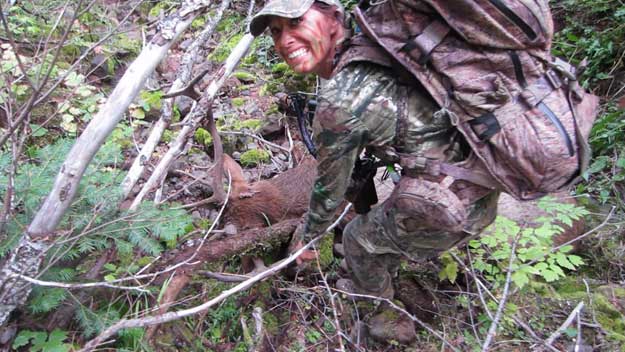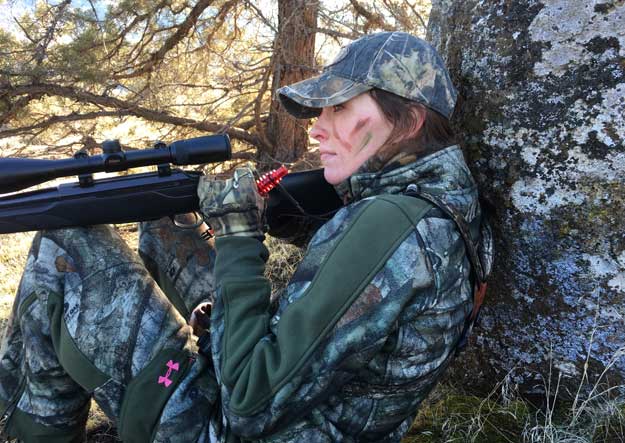 The second bull I took was during one of the greatest years we ever had elk hunting. Ryan and I decided to hike in six miles into the back country, set up a spike camp and then hunt out of the spike camp. We went to the deepest, darkest canyon we could locate the night before our hunt. We had found a herd of elk and put them to bed, before we went back to our spike camp and went to bed ourselves.
The second bull I took was during one of the greatest years we ever had elk hunting. Ryan and I decided to hike in six miles into the back country, set up a spike camp and then hunt out of the spike camp. We went to the deepest, darkest canyon we could locate the night before our hunt. We had found a herd of elk and put them to bed, before we went back to our spike camp and went to bed ourselves.
The next morning before daylight, we moved in close to the elk and started calling to them. They answered us. In that early morning glow before the sun came up, we could see a spike and 5x5 bull elk bugling to us each time we would call. We also saw the herd bull. He had so many cows that he wasn’t interested in Ryan and me. Ryan and I decided that the only way we had a chance to take a bull was to get the wind right, go down the canyon, cross over the bottom and get on the same side of the mountain where the elk were bedded.
As we watched the herd dynamics, each time we bugled, we saw the 5x5 bull run about 200 yards away from us and then turn around and bugle back to us. Ryan and I decided that the only way we would be able to take that 5x5 bull was for one of us to sneak down toward the bull and get as close as possible, while the other person stayed where we were and continued to call to him.
It was my day to be the shooter, because Ryan and I switch off each day being the shooter or the caller if we locate a bull elk. Ryan stayed above me at the top of the canyon where he could see me and the bull. As I went down the canyon, I used landmarks to try and determine where I was in relationship to where I’d last seen the bull. I’d give cow calls as I tried to move in on the bull. Although he’d run from bugling, he didn’t seem to feel threatened by cow calls.
As I cow called, I’d move forward as fast as I could without being seen through the brush to keep the bull from pinpointing my location. We had learned over the years that if we tried to call in a bull right to us, he usually would come in head-on and not present a good bow shot. Ryan told me later that he watched me call and move forward. Then he saw the bull coming to me, passing by me in the creek bottom and getting to the spot from where I just had called. When I got close, the bull bugled. I thought he was coming out of the bottom up to where I was, and so I came to full draw. That’s when I realized that the bull already had walked past me. I stayed at full draw and walked to a spot where I thought I might get a 40-yard shot. That bull came broadside to me right from the spot where I’d been calling from, so I took the shot.
Now I’m not really good at being able to see the flight of the arrow or the spot where the broadhead enters the bull, since I’m so focused on my pin sight and where I want the arrow to land. But the shot felt good and sounded good as the arrow hit the bull. I didn’t really know where the arrow had hit. Ryan came down off the mountain, and we discussed the shot. When we measured the distance to where the bull had been standing when I released the arrow, we realized that the shot was closer to 30 yards than it was 40 yards. So, I knew that the shot would have been a little bit high, but that I should have had a lethal hit.
Before we started blood trailing, we could hear the elk moan, telling us he was really close. Then we heard the bull fall. He sounded like he’d fallen a long way from where we’d heard him moan. When we followed up the blood trail, we saw that the bull had fallen off a steep cliff and landed in the creek bottom, 80 yards below us. We knew we couldn’t jump off or slide down the mountain. We had to pinpoint a safe way to get down off the side of the mountain into the creek bottom and then work our way to where the elk had landed.
When I first saw my elk, I was really, really excited. But that excitement didn’t last for very long, because the bull had landed in the nastiest place he could have where there was a lot of brush, logs, rocks and limbs. When the buck fell, he hit dead trees that fell on top of him. The first thing we had to do was get the trees off the bull just to reach him. I’d shot the bull early in the morning with a temperature of about 70 degrees. We had all day to get the bull field dressed, quartered and carried out of the canyon. We took a number of pictures and then began the ordeal of trying to field dress and quarter the bull.

Most of the time I can skin and quarter an elk and debone the meat in about 45 minutes. We generally can carry the meat and the head out in one or two trips, which is another great thing about hunting with Ryan. By hunting together, we can share in the work required to get the animal out. However, in this instance, neither one of us was prepared for what was about to happen.
Our euphoria at taking the elk didn’t last very long. The skies opened up, the temperature dropped to 30 degrees, rain started falling, and the fog arrived. We were carrying our frame packs and our knives, but we had left the day packs at the very top of the canyon - about a mile away. Of course, our day packs held our rain gear. Because the weather had been so beautiful when we left camp, we felt certain we wouldn’t need any of the gear in our day packs. By the time we got the bull field dressed and quartered, the weather was so cold, and our hands so cold that we couldn’t even hold our knives. Ryan and I each loaded a hindquarter in our packs to start carrying the meat out. We decided the shortest route for us to take to get the meat back to our truck was to climb up that steep 80-yard drop-off where the bull had fallen. There weren’t many rocks for us to negotiate, but there were plenty of raspberry bushes we could use to pull ourselves up the mountain.
When we reached the truck, we weighed the packs and each pack was 120 pounds. When I finally reached the top of the mountain, I was really feeling good about myself that I’d had the strength to carry that much weight up this steep mountainside. My brother is two years younger than me and he got to the top of the mountain before I did. He started getting frustrated, because I couldn’t climb as fast as he could.
Ryan and I never have fought a day in our lives and we’ve always been the best of friends, although we’re sister and brother. Ryan has never even said a nasty word to me. When I was almost to the top of the mountain, I could tell that Ryan was frustrated when he yelled down to me, “Is that the fastest you can go?” Then instantly he yelled back, “I am so sorry, Sis, I'm just so tired, hungry and cold. But I didn’t mean to yell at you.”
When we finally got the two hindquarters back to the truck we were both totally worn out. Ryan looked at me and said, “Someday, Sis, this adventure will be really funny, but not today.” We had gone by our camp, picked up our day packs and put on our rain suits. They helped some with the bad weather.
The next morning we met up with a friend of ours who had horses and earned a portion of his living packing out elk and deer from the mountains for the hunters who took them. He had his pack horses with him and was going from camp to camp, carrying his radio to see if anyone might need his help. We were more than happy to pay him to take his horses into that steep terrain that we’d just left. Before we left the elk, we had quartered and had him ready to pack out. So, all we had to do was help load up the horses. The packer got the rest of our elk out.
My brother was right. Years later we were able to laugh about that hunt. What made this hunt even more memorable was the day after the packer had helped us get my elk out of the woods, my brother took a 307-inch bull with his bow. The bull I’d taken the day before scored about 200 inches.
Part 1: Hunting with Family for a First Elk
Part 3: The Long Hike Elk Hunt



























